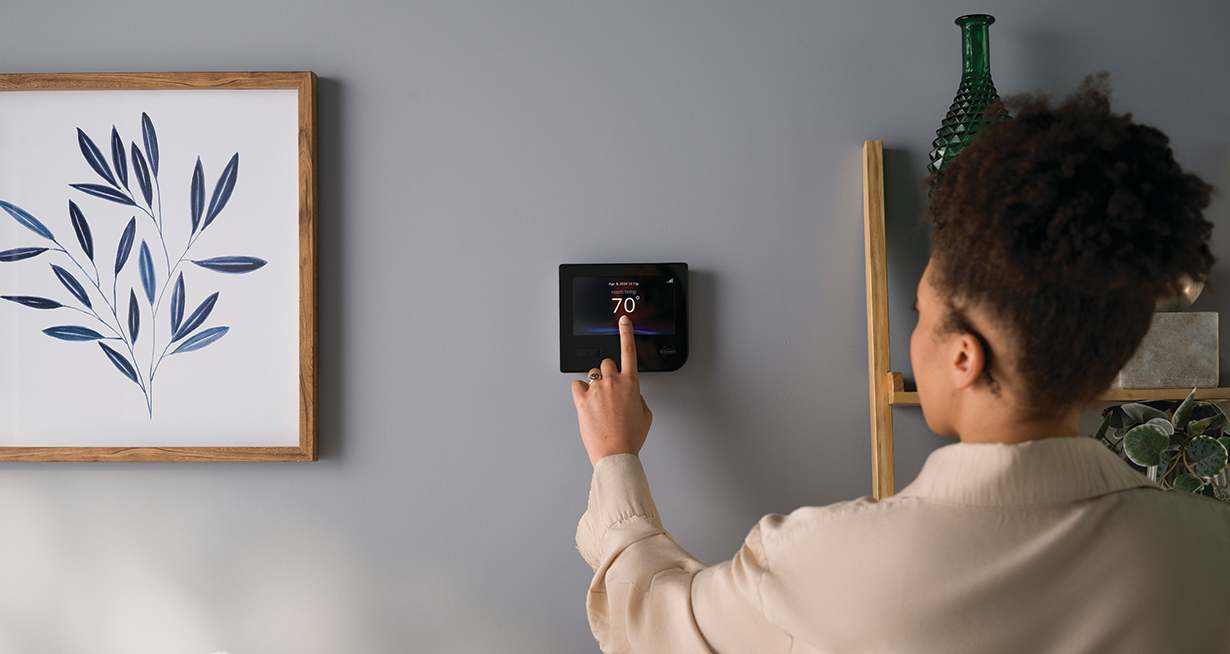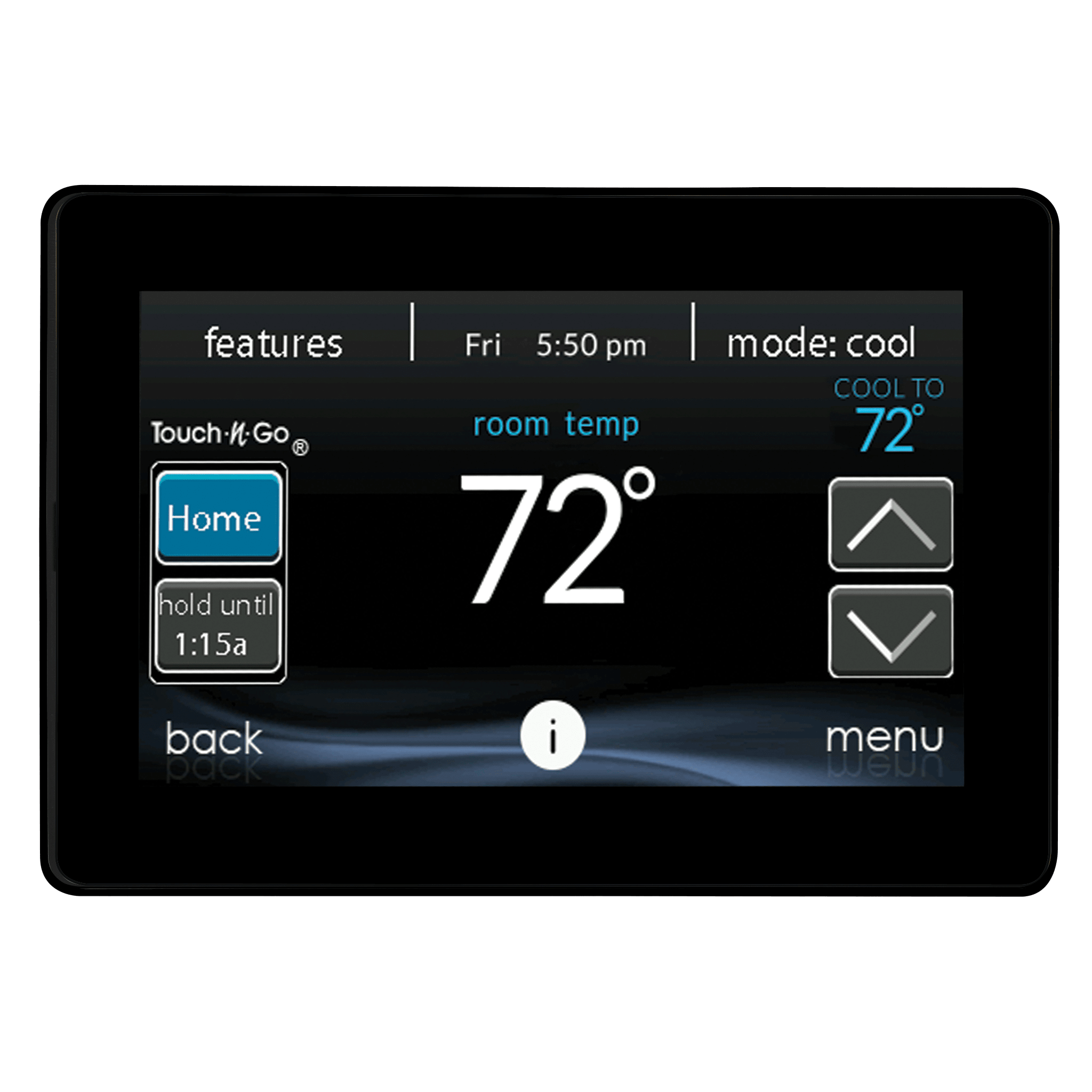About The Author: Travis Baugh is a Digital Brand Marketing Manager for Carrier, where he develops informative, straightforward content to help homeowners better understand heating, cooling, and indoor air quality. His writing is focused on empowering homeowners to make confident, well-informed choices about their home comfort systems.
Thermostat Replacement Guide: Signs It's Needed, Costs, and Selection
Thermostat replacement involves removing your existing temperature control device and installing a new one that better suits your HVAC system and comfort needs. It’s an important upgrade that can improve energy efficiency, ensure accurate temperature control, and enhance overall system performance. A properly matched thermostat helps your HVAC system run more effectively, saving energy and extending equipment life. Let’s dive into the signs thermostat replacement is needed, the benefits of updating your thermostat, thermostat replacement costs, and how to pick the right thermostat for your home.

Signs Thermostat Replacement Is Needed
Your thermostat plays a vital role in keeping your home comfortable and your HVAC system running efficiently. If it’s outdated or malfunctioning, it could be costing you comfort and money. Here are some common signs it may be time for a replacement:
- Inconsistent temperatures – Some rooms are too hot or too cold, even after adjusting the thermostat.
- Incorrect temperature readings – The thermostat doesn’t reflect the actual room temperature, affecting comfort.
- Frequent HVAC cycling – Your system turns on and off too often or runs longer than necessary.
- Unresponsive controls – Buttons or touchscreen features don’t respond, or the display is blank.
- Rising energy bills – Unexplained increases in your heating and cooling costs.
- No Wi-Fi or programmability – You’re missing out on remote control and smart scheduling features.
Benefits of A Thermostat Upgrade
Upgrading your thermostat can lead to more consistent comfort, improved energy efficiency, and easier control of your HVAC system. Modern thermostats—especially smart and programmable models—help reduce energy waste by adjusting temperatures based on your schedule or preferences. Many also offer remote access, letting you manage your home’s climate from anywhere. A new thermostat can also enhance the performance and lifespan of your heating and cooling system when properly matched as it can ensure your heating and cooling system’s load matches your heating and cooling demand.
Understanding Thermostat Replacement Costs
The cost of replacing a thermostat can vary depending on several key factors, including the type of thermostat you choose. Replacing a basic manual model is typically more straightforward, while installing a smart or programmable thermostat may involve additional setup or wiring adjustments—especially if your home is older or if your HVAC system requires advanced compatibility.
Labor costs can also influence the overall price, particularly if professional installation is needed to ensure proper setup and performance. While some thermostats are designed for DIY installation, others—especially smart thermostats—benefit from expert configuration from your local Carrier dealer to optimize energy savings and ensure system compatibility.
It’s also important to consider the long-term value, not just the upfront cost. Investing in a thermostat designed to help you save energy can help you reduce heating and cooling bills, extend the life of your HVAC system, and enhance comfort throughout your home. A local Carrier dealer can guide you through your options and help you choose a thermostat that fits your home, lifestyle, and budget—all while ensuring a smooth, professional installation.
Thermostat Replacement Consideration Factors
Replacing your home’s thermostat is a smart opportunity to improve comfort, reduce energy use, and better match your HVAC system to your lifestyle. The right thermostat replacement depends on a few key factors: your budget, long-term energy savings goals, system compatibility, and how much control you want over your indoor environment.
Start by thinking about your daily routine and comfort preferences. If you’re often away from home or want to optimize energy use, a smart thermostat with Wi-Fi® connectivity may be worth the investment. These models let you adjust settings remotely, learn your habits, and provide energy reports to help you make informed decisions. While the upfront cost is higher, smart thermostats can lead to significant long-term savings. Learn more about what temperature should I set my thermostat?
For homeowners who prefer a simpler approach, programmable thermostats offer scheduled temperature changes based on your routine—ideal for saving energy without daily adjustments. Non-programmable thermostats, the most budget-friendly option, are basic but reliable for those with consistent schedules or smaller systems.
Also consider your thermostat’s compatibility with your current HVAC setup. Advanced systems like variable-speed air conditioners or heat pumps typically require thermostats that can manage multiple stages or zones. Installing the wrong type may limit system performance or efficiency.
A Carrier dealer can evaluate your system, walk you through available options, and recommend the best thermostat that aligns with your goals. With the right match, you’ll enjoy better performance, easier control, and a more efficient home.
Carrier Thermostat Replacement Choices
Experience next-level home comfort with Carrier’s innovative smart thermostat options. Our Wi-Fi®-enabled thermostats are built to boost energy efficiency while giving you control over your home’s climate.
Infinity® System Control
The Infinity System Control is designed for homeowners who understand the value of precision comfort and an easy to use, intuitive user interface. With Wi-Fi® connectivity and built-in smarts, the Infinity® System Control puts you in command of comfort and energy savings like never before. Taking your comfort well beyond temperature control, the Infinity System Control can manage humidity levels, airflow, ventilation, indoor air quality and up to 8 zones, from wherever you are, with a connected smartphone or tablet. It's also compatible with Amazon™ Alexa™.
ecobee for Carrier Smart Thermostats
ecobee for Carrier Smart Thermostats can help provide energy savings, plus so much more than you’d expect from a smart thermostat, all in one beautiful design. Pair your smart thermostat with InteliSense-enabled Performance™ Series equipment, opt-in to data sharing, and enjoy the benefits of connected comfort. InteliSense technology gives your dealer the ability to remotely view the operational health of your system and use digital tools to provide more efficient customer service and remotely troubleshoot your system. ecobee for Carrier Smart Thermostats tailor themselves to your schedule, your personal comfort preferences and the weather outside. It can also provide details on savings each month and insight into your heating and cooling equipment performance.
Carrier Smart Thermostat
The Carrier Smart Thermostat has a clean, contemporary design which fits seamlessly with any home décor. With a simple touch, it clearly displays system mode, current temperature, fan mode setting, and set-point temperature. You can connect to this Wi-Fi connected thermostat using the Carrier Home app to create customized comfort schedules to match your lifestyle. Set the temperature for savings while you are asleep, or away, or comfort when you are awake and at home.

Work With a Carrier Dealer to Find The Right Thermostat For You
The right thermostat can make a big difference in your home's comfort and energy efficiency. A Carrier dealer can help you choose the ideal model based on your HVAC system and how you live. Schedule a consultation with your local Carrier expert today and discover the best thermostat options for your home.
Designed exclusively for our Infinity system products for advanced comfort control and energy management.
Saving energy is just the beginning. Works seamlessly with third-party smart home platforms, includes a built-in air quality monitor and added features like voice control and an occupancy sensor.
The Carrier Smart Thermostat is the latest and most affordable model in our growing family of Wi-Fi®-connected controls.
Thermostat Replacement FAQs
Some modern thermostats are designed for easy DIY installation, especially smart or programmable models. However, if you’re uncomfortable working with electrical wiring, it’s best to work with your local Carrier dealer.
Thermostat replacement costs typically range from $100 to $300, depending on the thermostat type and installation complexity. Smart thermostats tend to be on the higher end of the price range.
Signs of a bad thermostat include inconsistent temperature control, HVAC system not responding to settings, frequent cycling on and off, or no display/power on the thermostat unit.
Most thermostat replacements can be handled by an HVAC technician or a knowledgeable homeowner; however, if your thermostat involves complex wiring or low-voltage systems, hiring a licensed electrician or local HVAC dealer is recommended for safety and proper installation.




